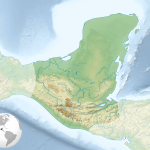Created by: saydapin
Number of Blossarys: 1
Located in the modern state of Chiapas, Bonampak is a Classic Period Maya site along the Usumacinta river. This is where many of the magnificent Maya murals were discovered in 1946. These paintings reveal the rich court life enjoyed by the Maya during the eighth century. The murals are among the finest to survive. The Maya were masters at mural painting using a vivid palette of blue, green, red, orange, and brown to great effect. Flat color was applied to sculpted or smooth surfaces, with variation usually achieved by diluting the pigment, as in thin washes of codex-style pottery painting rather than mixing pigments. Maya color was often translucent, so overlapping strokes would cause changes in hue. Paint was applied to fill in shapes, usually defined by the outlines. Colors were bright pigments from mineral sources, such as iron oxides, and were rarely mixed to produce different colors, with the exception of the mixing of yellow and blue to produce green. Color was used naturalistically as in the clothing of a king, but it also had symbolic value. Sometimes the color that appears on monuments and murals bears no relationship to real life objects.
Bonampak se nachází v moderním státě Chiapas, klasické období Maya stránky podél řeky Usumacinta. To je, kde mnoho z nádherné Maya fresky byly objeveny v roce 1946. Tyto malby odhalují bohatý soudu života požívají Maya v osmém století. Nástěnné malby jsou mezi nejjemnější přežít. Maya byli mistři na nástěnná malba pomocí palety modré, zelené, červené, oranžové a hnědé k velkému efektu. Plochý barevný byla použita na tvarované nebo hladké povrchy, s variací obvykle dosaženo zředěním pigmentu, stejně jako od keramiky codex styl Malování místo mixování pigmentů. Maya barva byla často průsvitné, takže překrývajícími se tahy by způsobilo změny v odstínu. Nátěr byl použit k vyplnění tvarů, obvykle definované obrysy. Barvy byly světlé pigmenty z nerostných zdrojů, jako jsou oxidy železa a jen zřídka stoupaly k výrobě různých barvách, s výjimkou míchání žluté a modré produkovat zelenou. Barva byl použit naturalistically jako oblečení krále, ale také měl symbolickou hodnotu. Barvu, která se objeví na památky a nástěnné malby někdy nemá žádný vztah k realitě objektů.


 English (EN)
English (EN) 